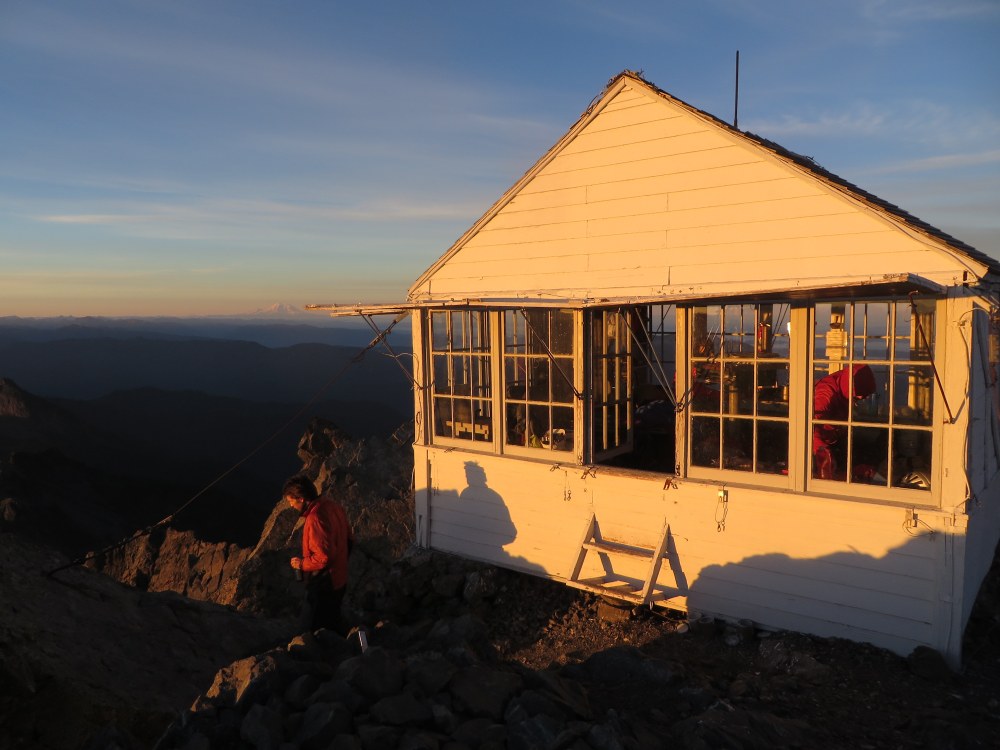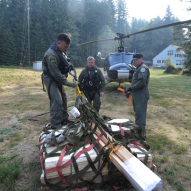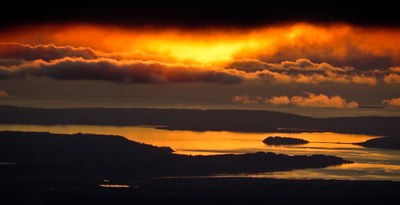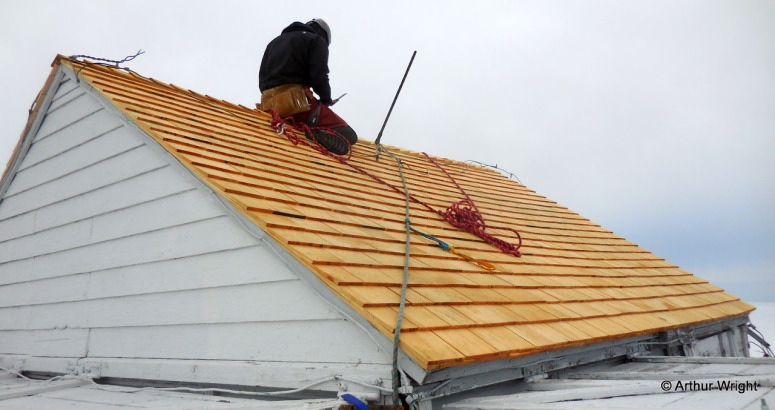
Three Fingers is, quite possibly, the most exceptional Grange Hall style L-4 lookout cabin ever built; it was, most certainly, built in the most impossible location.
Three Fingers Lookout is remarkably situated on a basaltic pinnacle of the southernmost peak for which it is named. The Lookout is well above timberline at +6,854 feet with dramatic sheer drop-offs on the north and south sides of the cabin. In order to access the cabin, one must transverse a 6.7 mile long Forest Service trail which crosses a permanent snow/ice field and ascend a vertical rock face equipped with wooden ladders and hand ropes. The Lookout commands a panoramic 360 degree view the length of the Cascade Range and of Puget Sound. –National Register of Historic Places Inventory-Nomination Form
EARLY HISTORY
On September 25, 1929, a young district ranger by the name of Harold Engles set out with his trail foreman, Harry Bedal, to “go take a look at the mountain”.
The two men stuffed sandwiches into their canvas pants pockets, picked up a map, compass, aneroid and tramped off through the tangled climax forest which blankets the lower flanks of Three Fingers. The area was sketchily mapped and, as far as they knew, had never been explored. That fact deterred neither Harold nor Harry. Crashing through the brush was part of the job and, in their case, almost a specialty. –Malcolm S. Bates, Three Fingers: The Mountain, The Men, and a Lookout
On September 24, 1931, fifteen feet of the south spire of that mountain were blown off with explosives set by Harry Bedal and his Forest Service trail crew; Harold Engles was one step closer to realizing his vision. In September, 1932, the cabin was completed and summer of 1933 would finally see the Three Fingers Lookout cabin staffed.
But it turns out that Three Fingers was a less than ideal location for spotting fires as the mountain and/or its valleys are often cloaked in clouds and fog. Indeed, it seems the whole of the Boulder River Wilderness (established in 1984) is a magnet for inclement weather when the rest of the mountains are basking in the glow of sunshine or stars. In 1943, the Three Fingers Lookout was abandoned.

THE MOUNTAINEERS
Whether through luck or location or perhaps a bit of both, the Three Fingers Lookout cabin survived the years while other lookouts were vandalized or burned to the ground. Harold Engels surmised that the only reason Three Fingers survived was because it was just too darn difficult to reach. Through the years, the cabin remained intact and occasional maintenance tasks were performed by several of the lookout’s former occupants along with family and friends, often in conjunction with the Forest Service who would supply materials and have them helicoptered in (either to the summit or to Goat Flats).
In 1972, Harold Engles and the Everett branch of The Mountaineers replaced broken ladders and window panes, installed new ceiling supports, and gave the place a new coat of paint. At the request of the Darrington Ranger District, 1985 saw the formation of the Lookout and Trail Maintenance (LOTM) committee within the Everett Mountaineers to officially take over routine maintenance of the cabin. Then, in 1986, with the help of some packers plus a little over a dozen volunteers, supplies and tools were carried over Meadow Mountain in preparation for a major restoration project. About a week later, Pat Tucker (daughter of Harry Tucker) and her husband arrived to spend a month in the lookout replacing the roof and making minor structural and window repairs. Three Fingers Lookout was now the responsibility of Everett Branch of The Mountaineers and the LOTM committee nominated the cabin to the National Park Service for inclusion in the National Register of Historic Places.
PREPARATIONS
The morning of August 24, 2015 dawned beneath clear skies with a haze of smoke in the air. Tremendous wildfires on both sides of the Cascade crest were affecting air quality throughout the Pacific Northwest – possibly the worst fire season in history. I’d thought about the smoke the day before, knowing Arthur, Brian, and Don were heading up the mountain and hoped it wasn’t making life miserable for them.

I was a little bit jealous of the others getting to go up and play while I stayed down low, but Arthur had asked me to facilitate the lift from Verlot and I knew I would be more valuable to him there – so I took one for the team. Besides, I was excited to be at the helipad when the helicopter took off with our precious cargo, and I knew my time on the mountain would come.
The airlift was the absolute crux of the project, replacing hundreds of hours of high-impact manpower that would have been required to haul the tools and materials to the lookout on foot. Without it, an estimated 100-person trips would have had to have been made – 100 pair of boots traveling a heavily eroded trail, 100 nights spent camping in an environmentally fragile area, 100 trips up a steep, icy snowfield and through a class 3 rock scramble, 100 ascents of the three precariously placed ladders followed by the tilted rock slab that leads to the front porch of the lookout, 100 opportunities for something to go wrong that could cause damage to property or, worse, injury to a volunteer. Instead, the lift went off without a hitch and the load was neatly delivered to the preferred location on the back porch. With this first task easily accomplished, the crew was able to set about other routine maintenance tasks – replacing broken window panes and failing hardware, painting and, as always, cleaning up other people’s trash.

Now it was time to play the waiting game – we needed a favorable weather window. As previously mentioned, weather in the Boulder River Wilderness can be fickle – add in some elevation and rain turns to snow. Snow does not facilitate safety when it comes to the replacement of a roof. And even if rain doesn’t turn to snow, rain makes those rock slabs slick as… well, you know the adage. Lucky for us, it looked like we were going to get that window without having to wait yet giving us just enough time to put a crew together. Eight days out, Arthur put out a call for hands and I started thumbing through my contacts to see if I could find anyone to flush out the team.
I should note that the project began over a year prior as project Manager Arthur Wright began coordinating the details for the roof replacement with all the various and sundry people and agencies that would be required to be involved. Documents had to be written, environmental reviews had to take place, committee approvals had to be obtained, materials and tools had to be purchased and assistance in transporting them had to be requested and directed, and in the middle of all that, somebody had to actually figure out what was needed to get the job done – right down to the proper number of nails! All of those logistics and minutiae were facilitated by long-standing Mountaineers member Arthur Wright; without his expertise and dedication, immense patience and tremendous sense of humor, this project would not have been completed.
HERE WE GO
Unlike the morning of August 24, the morning of September 6 didn’t dawn with fair skies. Instead, terse downpours came and went, leaving us with a modest feeling of dread. Yet we knew the forecast said it was supposed to clear (sometime in the not-too-distant future), so we held on to that piece of fortune telling and tried to maintain our enthusiasm. When I asked Arthur if there was anything else I could do for him before we headed out to meet the others, he merely replied “Make the rain go away.” Well, by the time we made it to the road closure, it mostly had, thus lifting everyone’s spirits. Plus, despite the weather, we were about to undertake a really cool, once-in-a-lifetime project. How often do you get to replace the roof on top of the world? And so on a Sunday morning, our merry band of four – Matt, Skylar, Arthur and myself – began the arduous trek to the remote yet renovated summit of Three Fingers in order to begin prep work for the installation of a new roof.

The trip to Three Fingers begins with nearly nine miles of road that is closed to motorized vehicles – because the bridge will no longer safely support vehicular loads – which leaves the traveler with two options: walk/run the road (who runs with a 50# pack?) or bicycle the road. We chose the latter, but what that really means is mostly pushing said bicycle up 8.6 miles and 1,400′ (still with a 50# pack). It seems a bit counter-intuitive to make the road portion more difficult, but the payoff is on the trip out when you can coast down that road on your bicycle and be back at your car in a little over an hour. On the way up? I think it took us about 3 hours to reach the trailhead at Tupso Pass.
With bikes stashed, we once again saddled up with our heavy loads and began hiking the two-and-a-half miles from Tupso Pass to Saddle Lake along the rockiest, rootiest, wettest, there-is-no-more-tread-it’s-just-a-creek-bed-of-a-trail. Like many other trails off the Mountain Loop Hwy, this trail sees little, if any, maintenance. (Please write to your Congressperson and tell them to fund the Forest Service properly, including funds for recreation.) Several blowdowns – including a new one that came down within the past two weeks – added to the adventure. Finally, some 2+ tedious hours later, we reached Saddle Lake; then, after a short stop for food and water, we were on our way again, now heading for Goat Flats.
The two miles to Goat Flats went by with relative ease as this section of trail was in much better condition. Even so, upon arrival, we were all quite happy to call it quits and make camp for the night; our bodies had thoroughly tired of carrying their heavy loads. After settling on some pretty traditional camp spots, it wasn’t long before all four of us were snuggled inside our portable homes and well on our way to sleep. It had been a long day.

Morning came and skies were clearing but we were waiting for the sun to warm the earth and dry our tents – our packs were already heavy enough without carrying wet gear. We slept until 7, had a leisurely morning, and didn’t hit the trail until nearly 10.
The mile-and-a-half to Tin Can Gap sped by as did the rest of the journey and, by early afternoon, we were ascending the icy snowfield that led to the rock scramble and the notorious ladders which would place us on the summit. Upon arrival, we quickly settled ourselves in to what would be home for the next few nights then got to the business of why we had come.
LET’S GET TO WORK
No project trip to Three Fingers is ever solely for the purpose of said project; there’s always a plethora of maintenance tasks to be done – hardware repairs, painting, cleaning, and this time, leveling the cabin – Three Fingers was sagging a bit in her midsection and needed a little propping up. Matt took on the potentially claustrophobic task of harnessing up and climbing under the cabin. From there, he could set the jack under the support beam, crank it up, and build a few new stone monuments (from rocks that Skylar and I collected) for the beam to rest on. Serious business aside, we thought he looked a bit like the Wicked Witch of the East with nothing but his legs hanging out from under the cabin. Once the building was propped back up, we spent the days plugging away on little tasks while enjoying our surroundings, the view, each others’ company, and the sunsets – there simply is no better place to watch the day come to an end.
Every evening after dinner, Arthur would place a radio call to his wife Ann, our communication liaison with the outside world. When Arthur checked in on Tuesday night, there was unfortunate news… Our lead roofer, wasn’t coming – he’d been struck by the flu. But Ann noted that additions to the ground support team and our secondary roofer would be on their way in the morning. I could tell that news put Arthur’s mind into overdrive as he thought through all the potential ramifications and worked to find solutions; we had come a long way and so much work had already been done – long before we even set foot on the trail – for this to be just another “maintenance” trip. I felt my own heart sink in empathy for what Arthur must have been feeling at that moment. But, Arthur being Arthur, nothing changed. We still had a roofer coming and if he was willing to take on the challenge, then Arthur was willing to oversee and support the project in any and every way possible – the job just might take a little longer.

CHANGING OF THE GUARD
Come Wednesday morning, it was time for a crew change; Arthur and I would be staying, but Matt and Skylar had to leave. In their stead, we would be gaining Dustin, Don, and Lois. While waiting for reinforcements to arrive, Arthur and I spent the day setting a safety line and then installing the roof anchors that he and Dustin would tie into while doing their work.
While we had hoped the others would arrive Wednesday afternoon, Arthur and I remained the sole occupants of the lookout. The day’s routine call to Ann told us that while the ground support team had started their journey fairly early in the morning, our roofer wasn’t on his way until mid-afternoon. We also learned that Don and Lois would spend the night at Goat Flats; we assumed that Dustin would as well. Yet just as Arthur and I were finishing up dinner and settling in for the evening, we saw a headlamp approaching up the slab. It caught us quite by surprise. Here came Dustin, arriving as a boundless bundle of energy having traveled from car to lookout in five-and-a-half hours. FIVE-AND-A-HALF HOURS! I was in awe – I think Arthur was too – and now that we had a roofer, Arthur felt reassured. Dustin just felt hungry – tremendously hungry; I don’t think he’d stopped to eat more than a bar or two during the whole trip up. We watched him scarf down cheese and salami followed by more cheese and more salami then, since morning would come early and there was an exceptional amount of work to be done, we turned in for the night.
OFF WITH HER HEAD ROOF
Thursday’s project was removal and containment of the existing roof, normally not a hugely time consuming process, but nothing on Three Fingers is normal. Unlike the process of re-roofing your own home where the old shingles can simply be tossed off the roof into a waiting refuse bin, here they had to be loaded into burlap bags so a full bag could be carefully tossed onto the back porch and emptied. From there, the shingles were cleared of nails, sorted, and packaged into bundles that could be hauled out. I considered it my opportunity to play Tetris with old, broken shingles.
While Dustin began the demo of the old roof, I began with one of the critical tasks of the day, any day, and made a water run. Another not-normally-time-consuming process, a water run meant descending to the base of the snowfield approximately 400’ below the lookout. Here’s what that looked like… Collect all available water bottles and load into backpack. Attach ice axe and crampons to pack as well. Descend the three ladders. Navigate the rock scramble to the top of the snowfield. Remove crampons from pack and strap onto boots. Descend snowfield with crampons on feet and ice axe in hand. Navigate to edge of snowfield, remove crampons, then travel to free-flowing stream. Collect and sterilize water (approximately 3-4 litres per person per day). Pack now-full water bottles back into backpack. Hoist now-heavy pack onto back (water weighs 2.2 lbs. per liter). Travel back to snowfield, re-attach crampons, re-climb the snowfield, remove crampons, navigate the rock scramble, climb the ladders, scamper to front door of lookout. Needless to say, this and other ground support tasks were vital to efficiency of the roofing team. Every little thing that Dustin didn’t have to do kept him on the roof while Arthur continued to supervise. I was happy for the exercise.
Upon my return, I found a growing pile of debris waiting for me and began my job of creating order out of chaos. By early afternoon, Don and Lois had arrived and were tasked with helping to bundle the old roof. Before long, we’d made substantial progress, enough for Arthur to make arrangements to get the materials transported off the mountain.
DEPARTURE
Thursday flew by with everyone thoroughly focused on their individual tasks and suddenly (it seemed), Friday arrived – too soon for me. It was my departure day and I had hoped to see the project through but the roof work had barely begun. Alas, I was going to have to leave the cabin without seeing the finished roof, but at least I was granted with beautiful weather for the hike out. Unable to stay for the weekend, Lois hiked out with me. As I left this special place – feeling even more connected to it than I had before – Dustin had just begun the long process of nailing new shingles to the sub-roof, and I felt confident that Arthur, Dustin, and Don would get the job done.
The hike out goes much faster than the hike in (funny how that happens), at least until you get below Saddle Lake. While we admired the colors of autumn, marveled at the long-stretching views, and were treated to a billy goat sighting below Goat Flats, the journey down remained uneventful. I kept our team moving to be sure we were back to our cars before dark – I was not about to ride that road at night, even with a headlamp. After being out for 6 days, I was anxious to get home while Lois was wanting to rest for a spell, so we parted ways at the trailhead and I coasted nearly all of the 8.6 miles back to my car.
In the end, the project ran three days longer than initially intended – removal of the old roof couldn’t begin until we were sure we’d have a roofer to install a new one, the process of demolishing the old roof was slower than initially anticipated, and it was expected that we would have two roofers instead of one. Because of work commitments, Don also had to leave before the project was completed; he hiked out on Sunday which was just as well – they’d all but run out of food. Arthur and Dustin exited on Monday – tired, hungry, smelly, and feeling the satisfaction of a job well done.

POSTSCRIPT
It took over 400 hours of volunteer-only labor to re-roof the Three Fingers Lookout. Whenever you are lucky enough to encounter an old fire lookout, please remember what it takes to look after these special places. Sign only the logbook, clean up after yourself, pack out your trash, and leave nothing behind – in the end, it’s just more trash that someone else has to carry out. Oh, and volunteer whenever and wherever you can. To be put on the Three Fingers mailing list, email threefingerslookout@gmail.com. For more information visit the Everett Mountaineers' Lookout and Trail Maintenance Committee.
This post is an excerpt from Gwen Tollefson's blog Boots on Trail. To see the entire piece, including many more photos, please visit Boots on Trail. All content and images © Gwen Tollefson.
 Gwen Tollefson
Gwen Tollefson